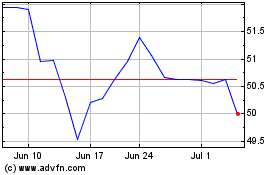By Saabira Chaudhuri and Jennifer Maloney
Americans are increasingly laying off the booze, prompting the
world's biggest brewers and liquor companies to push beyond their
traditional fare and roll out teas, energy drinks and nonalcoholic
spirits.
New data show that U.S. alcohol volumes dropped 0.8% last year,
slightly steeper than the 0.7% decline in 2017. Beer was worst hit,
with volumes down 1.5% in 2018, compared with a 1.1% decline in
2017, while growth in wine and spirits slowed, according to data
compiled for The Wall Street Journal by industry tracker IWSR.
The fall in alcohol volumes reflects "a growing trend toward
mindful drinking or complete abstinence, particularly among the
millennial cohort," says IWSR's U.S. head Brandy Rand. Wine grew by
0.4%, down from 1% the year before, while spirits climbed 1.9%,
compared with 2.2% in 2017.
In response to the slowdown, alcohol makers are trying to
diversify. Molson Coors Brewing Co. has turned to kombucha,
Budweiser brewer Anheuser-Busch InBev SA sells a spiked coconut
water, and Smirnoff maker Diageo PLC wants teetotalers to start
mixing cocktails with a pricey, alcohol-free gin alternative.
IWSR forecasts low- and no-alcohol products in the U.S. -- still
a small slice of the market -- to grow 32.1% between 2018 and 2022,
triple the category's growth over the past five years. IWSR's sales
figures are based on products shipped.
Molson Coors, grappling with weak sales of Coors Light, wants to
build out a broad portfolio of "brewed beverages," Chief Executive
Mark Hunter said in an interview. That means beer, tea and perhaps
even coffee, he said. The company has invested in Boulder,
Co.-based Bhakti Chai Tea Co. and bought a California-based maker
of kombucha -- a fizzy, fermented tea.
"We're certainly not sitting on our hands," Mr. Hunter said.
Industry executives say drinkers are increasingly concerned
about health and that younger generations socialize differently
from their parents, drinking less.
"Twenty years ago we didn't have coffee shops open late, and
pubs and bars open for coffee," said Ben Branson, chief executive
of nonalcoholic distilled spirit maker Seedlip Ltd., which is part
owned by Diageo. "People are favoring experiences over 'lets go
drink on a night out.'"
While booze makers are partly responding by pushing pricier
tipples -- helping sales by value grow despite lower volumes --
they're also scrambling to offer a wider selection of drinks.
Brewers, in particular, are under pressure as consumers abandon
mainstream beer.
AB InBev last year created a new global position, head of
nonalcoholic beverages, to lead its efforts to diversify.
Nonalcoholic drinks -- including energy drinks and nonalcoholic
beers -- already make up more than 10% of the Bud brewer's volumes.
In 2017 it acquired Hiball Inc., a maker of organic energy drinks.
AB InBev recently began selling Budweiser Prohibition brew -- a
nonalcoholic version of its flagship beer -- in Columbus and
Detroit. Nonalcoholic beer volumes in the U.S. are expected to
climb 9.3% over the next five years, according to research firm
Euromonitor.
The beer company also has stepped up its efforts to woo
consumers defecting to wine and cocktails. Its craft-style
breweries in Oregon, California and New York have served as
incubators for new, boozy versions of coconut water, matcha tea and
agua fresca, a Mexican fruit-juice drink.
The brewer plans to later this month launch a seltzer brand, Bon
& Viv, which it will advertise alongside its beers at the Super
Bowl.
"People are looking for something that tastes good but also
allows them to live well," Chelsea Phillips, head of marketing for
AB InBev's Beyond Beer division in the U.S., said in an
interview.
Volumes of ready-to-drink alcoholic beverages jumped 6.1% last
year, according to IWSR, driven by hard seltzers, which executives
say appeal to consumers because of their low calories and
sugar.
Distillers also are embracing the popularity of lower-alcohol
drinks.
Late last year, Diageo launched a lower-alcohol, botanical
version of Ketel One, which it said has 25% fewer calories than the
regular vodka. Alcohol content is 30% compared with 40% in regular
Ketel One.
Diageo Chief Executive Ivan Menezes said last year that adults
opting for lower alcohol options was "an important trend over the
next many years" and that the company was "putting a lot of focus
behind it."
Diageo has been working to help expand Seedlip, in which it took
a minority stake in 2016. The London-based brand, which can be
drunk with tonic or used in cocktails, markets itself as solving
the dilemma of "what to drink when you're not drinking."
Seedlip is available in 6,000 locations, including 500 in the
U.S., where it recently opened its first office. The upscale brand
sells three variants, which cost about $30 a bottle upward.
This spring, Seedlip plans to launch a new nonalcoholic brand
called Æcorn Aperitifs, designed to be drunk before dinner. The
liquid will be made from English grapes, herbs, roots and bitter
botanicals, and is aimed at consumers who want a nonalcoholic
option to drink with food.
Write to Saabira Chaudhuri at saabira.chaudhuri@wsj.com and
Jennifer Maloney at jennifer.maloney@wsj.com
(END) Dow Jones Newswires
January 17, 2019 11:51 ET (16:51 GMT)
Copyright (c) 2019 Dow Jones & Company, Inc.
Molson Coors Beverage (NYSE:TAP)
Historical Stock Chart
From Mar 2024 to Apr 2024

Molson Coors Beverage (NYSE:TAP)
Historical Stock Chart
From Apr 2023 to Apr 2024
